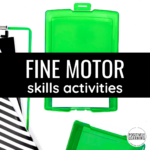
If you're on the hunt for activities to boost the fine motor skills of young learners, you've stumbled upon a GOLDMINE in this blogpost. Learn about how to easily incorporate fine motor skills puzzles using task boxes and the significant impacts on child's development.

Table of Contents
ToggleEver noticed the sheer joy on a child's face when they slot that last jigsaw piece in? It's that's huge sense of accomplishment AND speaks volumes to the development of fine motor skills, hand-eye coordination, and cognitive skills, too!
Puzzles are more than just a great fine motor activity for rainy days; they’re a great way to enhance fine motor development. Whether it's simple jigsaw puzzles for younger children or a massive wooden jigsaw puzzle for older children, there’s good reason they’ve been a beloved fun toy for such a long time.
Completing puzzles requires precise movements. Grasping small pieces, turning them to fit just right, that little pincer grasp coming into play—it all adds up. For little kids, these small muscle movements are crucial. While gross motor skills get them running and hopping, it's these tiny, coordinated movements, like picking up small objects or sewing cards, that prepare them for tasks like writing or buttoning a shirt.
Visual-spatial awareness and visual perception get a significant boost with puzzle play. Recognizing different shapes, figuring out where each piece of the puzzle fits, or understanding the different types of puzzles aids in visual understanding. That farm animals piece? It isn’t just cute; it’s helping with shape recognition. Fairy tales puzzles? They're more than just enchanting; they're a great opportunity to enhance visual storytelling skills.
Puzzles aren’t just about fine motor activities. They play a big part in cognitive development, boosting problem-solving skills, and even mathematical concepts. Trying to fit that straight line edge or recognizing patterns in simple shapes sharpens logical thinking. A completed puzzle is not only fun, but also evidence of a child’s ability in basic problem solving!
Who said puzzles are a solo activity? They also provide plenty of opportunities to practice social skills. Children learn to share, take turns, and even narrate stories. A puzzle with characters from fairy tales might just lead to an impromptu storytelling session. What a fabulous way for language development!

From knobbed puzzles for little hands, peg puzzles for those ready for a bit more of a challenge, to large floor puzzles that are great for teamwork—there’s something for everyone For those just starting out, tactile puzzles with large knobs or larger puzzle pieces are a great way to begin. As they grow, they can transition to puzzles with smaller pieces, demanding more fine motor precision.
BONUS TIP: Need puzzles on a budget? Wooden puzzles can be quite an investment. Turn individual puzzle task boxes into a more accessible option by adding a bit of “lift” under each puzzle piece. Simply attach a piece of adhesive (like Velcro) under the puzzle pieces. It makes them MUCH easier to pick up off a flat surface, like the floor or a table.
While puzzles are incredible for fine motor skills toys and beyond, it's essential to remember that every child is unique. Some might jump straight to difficult puzzles, while others may take their time with simpler ones. It's all a part of the beautiful journey of early childhood. So, whether you're piecing together a story from fairy tales, solving mathematical concepts with jigsaw pieces, or simply enjoying a great time with floor puzzles, you're making significant strides in areas of development.
Fine motor development is crucial for many important life skills, and incorporating these activities into your classroom can make a significant impact on your special education students. Don't forget to have fun and get creative with your task boxes – the possibilities are endless!
If you're looking for instant access to hundreds of ready-made fine motor task cards, be sure to check out the Task Box Dollar Club, a time-saving task box membership! It's full of lots of fine motor activities and a growing task box library designed for busy teachers and families!
Special education teachers, child development experts agree: puzzles are much more than a pastime. They're a critical tool in shaping the coordination of small muscles, cognitive skills, and even language development in young children. So the next time you see a child engrossed in piecing together a puzzle, know that it's not just play; it's growth!
Till next time, keep puzzling and keep smiling! Remember, every piece, however small, contributes to the larger picture of a child's brilliant brain development. Happy puzzling!
About The Author
I'm Jennifer, your advocate for creative and inclusive education. With years of special education expertise and a heart for mentoring teachers, I'm your go-to for resources that matter. Learn more about my mission for Positively Learning here.

I’m Jennifer and I was a special educator in the elementary school setting over the past decade. I entered the classroom every day dedicated to making learning inclusive AND engaging.






This website uses cookies to ensure you get the best experience on our website. See full disclosure here.
This website uses cookies to ensure you get the best experience on our website.
See full disclosure here.